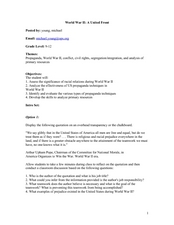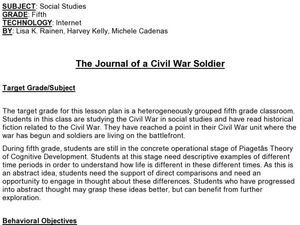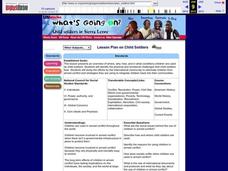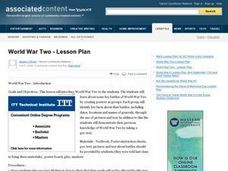Curated OER
Civil Disobedience Action Plan
Students investigate incidences of civil disobedience. In this civil disobedience lesson, students watch a video and read a newspaper article on civil disobedience. Then, in groups, they search a current newspaper for examples of civil...
Curated OER
World War II: A United Front
Students interpret historical evidence presented in primary resources. In this World War II lesson, students examine racial relations during the war and then examine propaganda techniques employed by the United States...
Curated OER
African Americans and the Military of World War II
Fifth graders view a news reel of African Americans in World War II. In this World War II lesson plan, 5th graders discuss the newspaper clippings they get to view and hypothesize about why the African Americans use military news clips....
Curated OER
America's Wars
Students classify information regarding American involvement in wars. In this classification lesson, students examine the causes of the war in which the United States has been involved, and classify them as mainly political, social,...
Curated OER
"The New Television Set" a Gateway to the Post World War II Era
Eleventh graders demonstrate their knowledge of the effects of television on the political, economic, religious, social, intellectual and artistic life of the US nation from the 1950's. Research how television shaped public opinion with...
Curated OER
Brother Against Brother
Eighth graders read Across Five Aprils and correlate it to a unit on the Civil War. They culminate the unit by writing a a piece of historical fiction in the first person entitled "Brother Against Brother."
Curated OER
Prairie Grove Battlefield
Students examine the battle of Prairie Grove and Arkansas's role in the Civil War. They discover the realities of war on the soldiers and civilians. They analyze historical documents for content.
Curated OER
Historic Dates and Timeliner Unit
Eighth graders research a specific Civil War battle including important date, major events and outcomes of the battle. They use their notes and information to create a timeline of the battle using Timeliner software. Finally, they decide...
Curated OER
City Bound
Fifth graders identify the reasons for people migrating to cities after the Civil War. Using population data, they discover why populations in cities rose while rural populations fell during 1860 to 1900. They discuss the impact a...
New York State Education Department
US History and Government Examination: January 2011
The presidencies of John F. Kennedy, Richard Nixon, and Ronald Reagan were defined by the Cold War. Using primary source documents and scaffolded analysis questions, pupils explore the effect the Cold War had on these presidencies. A...
Library of Congress
Stars, Stripes and Symbols of America: Comparing Our Flag, Past and Present
Your young historians will compare and contrast the details of the American flag today with an an image of the nation's flag from the post-Civil War era, and identify the flag's importance as a national symbol through analysis...
Curated OER
The Journal of a Civil War Soldier
Fifth graders write a response in their journals about the fictional thoughts of a Civil War soldier. They use specific web sites in order to research the life of a soldier during the Civil War.
Curated OER
Child Labor in Maryland: An Historical Investigation
Tenth graders, after reading two excerpts about contemporary child labor situations, discuss two broad questions in detail along with the industrial boom following the Civil War conditions in the United States. They investigate how the...
National Park Service
The Battle of Stones River: A Contrast in Leadership Styles
US Commanding General William S. Rosecrans led the Union soldiers and Confederate Commanding General Braxton Bragg led the rebel army at the Battle of Stones River. Young historians compare how the leadership styles of these two...
Curated OER
Reporting from the Front Lines
Students examine the battle of Gettysburg as they write news articles. In this Battle of Gettysburg instructional activity, students become familiar with the job of the news reporter as they report on the events of the Battle of...
Curated OER
Emancipation Proclamation
Students examine the Emancipation Proclamation. In this Emancipation Proclamation lesson, students examine the document and respond to 6 questions regarding it.
Curated OER
History Biographies
Students explore the life and the contributions of five people from U.S. history in the five lessons of this unit. james Madison, Dolly Madison, Sequoyah, Harriet Tubman, and Clara Barton are presented to students for exploration and...
Curated OER
Children at War
Students conduct Internet research to investigate the use of children in combat throughout the world. Students read personal testimonies and analyze media coverage of children in combat.
Curated OER
Lincoln and Photography: A Closer Look
Students compare and contrast the Lincoln portraits using a Venn diagram and included analysis tool. In this presidential photography lesson, students write a journal entry and a letter as if they were Abraham Lincoln. Lastly students...
Curated OER
Social Changes in America Caused by World War II
Students research and examine the social changes that occured in the United States during World War II. In pairs they conduct research using a variety of resources, and organize and compose a "Guide to Life" for veterans returning home...
Curated OER
World War II
High schoolers create a Powerpoint presentation covering key information regarding a World War II battle and present the information to the class in the form of an oral presentation. They then will turn in a summary report including two...
Curated OER
Denying Civil Rights
High schoolers continue their examination of the United States Constitution. Individually, they identify events in which the government has limited our civil rights and write an essay. In groups, they debate the issue and answer...
Curated OER
Billie Holiday's Song "Strange Fruit"
Pupils analyze a variety of primary source materials related to lynching (news articles, letters written to or written by prominent Americans, pamphlets, broadsides, etc.) in order to assess the effectiveness of the anti-lynching...























